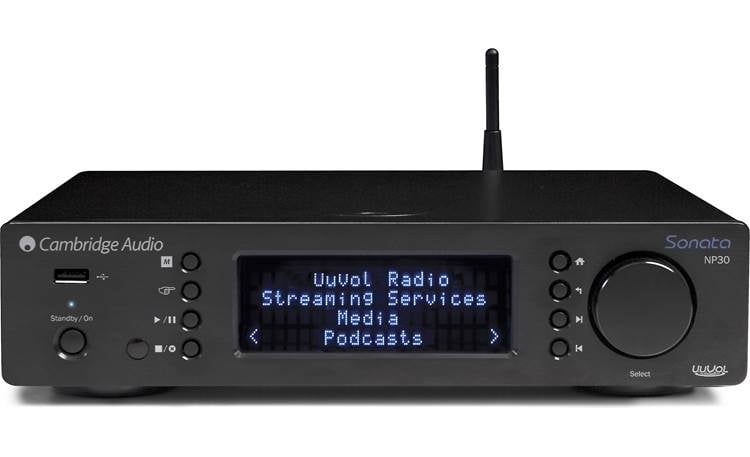The £400 NP30 network music player was released in 2011 and was an inexpensive yet competent network music player. It supports 24-bit WAV and FLAC files (as well as normal 16-bit), but not Apple Lossless. MP3, AAC, WMA, and OGG Vorbis are also supported. It has direct access to music streaming services such as Rhapsody and Pandora, as well as internet radio (and associated podcasts). It connects to your PC, Mac, or Network Attached Storage device through Ethernet or Wi-Fi (IEEE 802.11 b, g, or n bands). For the Apple iPhone, Cambridge Audio offers the UuVol remote app, which provides quick access to all of this.
The unit itself is packaged in Cambridge Audio’s standard ‘midi’ case (67x270x285mm, 2.1kg); for the price, it’s extremely well built and doesn’t feel ‘cheap,’ merely utilitarian. It’s simple to set up; simply turn it on, and it will search your surroundings for a wireless network, prompting you to enter your password. If you don’t want to read the manual, the text entering routine isn’t ideal — it’s a little difficult, and it’s not immediately evident how to fix your mistakes. After a little tweaking, it discovered my network and began scanning for music-touting PCs; it quickly discovered my Mac, which had the Twonky uPnP server software installed, and I was able to access my computer’s music library.
The NP30 comes with all of the necessary network music-playing hardware, including a Wolfson WM8728 24-bit/96kHz capable DAC. This is the same IC used in the new Cambridge Audio 350C CD player, though comparable Wolfson DACs are also used by Logitech, Naim, and Arcam; it can work at 16 to 24 bits and 22.05kHz to 96kHz. There’s a small switch mode power supply that runs between 120 and 240 volts, as well as some jitter reduction circuitry that Cambridge Audio claims is less than 200pS. S/PDIF coaxial and TOSLink optical digital outputs, as well as two USB 1.1 connectors for memory stick playback, are all found on the back panel, which is powered by a small figure of eight IEC mains input.
We’ve got a device that sounds a lot like a nice modern budget CD player, which isn’t unexpected given that it uses the same DAC as most of them! In absolute terms, this means a clean, open, and tidy presentation with good depth and insight into the sound, but a little light in the bass, slightly suppressed in the treble, and modestly opaque across the midband. This is a pretty good outcome from any form of digital product for £400, and it is absolutely not to be sniffed at.
The natural flow of Madonna’s Holiday, which was recorded from vinyl at 16/48, struck me; the NP30 is detailed enough to tell you a lot about the original recording, producing a huge and energetic sound with exquisite texturing. For example, the track’s classic synthesizers sounded appropriately squelchy and thick – just how they should – while the drum machine clicked and fizzed away in the background. Madonna’s vocals were well-received, having a nice, realistic tone and good timing. Underneath, a synthesized baseline rumbled away, sounding fairly fruity and punchy. Overall, I heard a respectable rendition of a great pop song with no indication that I was listening to a low-cost digital product of any kind.
With The Waterboys’ Glastonbury Song (16/44 WAV), I moved on to some big nineties power pop, and the NP30 once again satiated my thirst. This little silver box sounded at ease and in control even when played via my high-end reference system, which cost many times its price. The Cambridge carried a lot of the strength of this amazing album, with a superbly booming piano and great huge thumping snare and kick drums, finished off by a clean and realistic hi hat sound. Up top, there was no fizz, and the NP30’s crimes were omissions, missing just that final nth degree of sparkle and finesse. I was once again delighted by this device’s melodic flow; everything rocked and rolled along nicely; there was no sensation of it producing a drab, pale rendition, as I had anticipated. Again, this did not appear to be a low-cost digital device.
The Beatles’ music is now available in 24/96 FLAC format. While My Guitar Gently Weeps, I was struck by the difference in soundstage depth; the speakers seemed to disappear into the room in a way that 16/44 never quite managed; at the same time, the track shimmered with detail, giving a lovely feel to singer George Harrison’s voice; it really conveyed the fragility of it, and its unique tonal qualities. Although this track did underline for me that whatever the NP30 is, it is not very warm, if there is one criticism that can be levelled at it, it is the general tone of the unit, which is never exactly brimming with warmth and body.
Summertime, another off-LP recording at 16/48, corroborated this; the song wandered along with an appropriately relaxed rhythmic tempo, had a decent tonality with no harshness to the flutes, and a reasonable degree of stage depth that really gave me the feeling of the Newport Jazz Festival (which is where the original recording was made). In absolute terms, dynamic transients were a little compressed, and the very lowest levels of information were slightly muffled, but overall, it was a really enjoyable experience.
An outstanding, well-organized budget product of its time, even by today’s standards, it’s simple to use, appealing to the eye, compact in size, and well-built for the price. But, most importantly, it functions properly, producing a pleasant sound that is far superior to that produced by low-cost computer peripherals. It’s no longer available, but it’s a cheap secondhand way into streaming that may be all most computer audiophiles will ever need.



